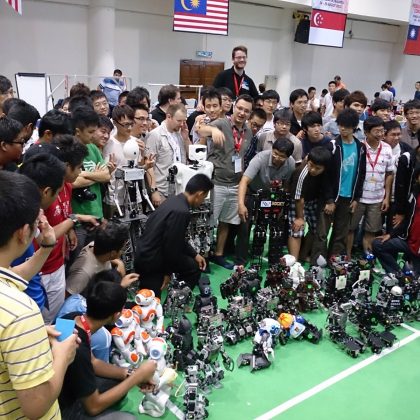Robot Athletes and Entertainers
It is with great pleasure to present to you the Special Issue on Robot Athletes and Entertainers, from The Knowledge Engineering Review journal. The special issue focuses on the development of robots that are able to perform in environments and activities that were designed for humans. This requires that the robots are able to adapt to different environments, perform a variety of functions, and perform them efficiently. All of these are essential aspects of intelligence.
The creation of robot athletes is a novel benchmark problem for techniques in artificial intelligence, machine learning, computer vision, and intelligent robotics. The goal is to develop intelligent robot systems that can participate in sports events following the same rules as humans. Sports provide extremely important and timely benchmark problems for research into the areas mentioned above. Furthermore, it is motivating for students, faculty, and other participants. One advantage of robot athletes as compared to other robot problems is the fact that the rules and the methods of evaluation have developed since at least when the first athletes competed in the games in Olympia, Greece or possibly even earlier. Several papers in this special issue discuss lower level issues in robot athletes including active balancing and energy efficient walking gaits. Higher level navigation issues such as orienteering, obstacle avoidance, and simultaneous localization and mapping are also discussed.
There are two papers that describe the background and issues in robot archery. The goal of this research is to develop a humanoid robot that can compete at the 2022 University games in archery. This research does not only have practical implications for high accuracy mobile manipulation (the accuracy of the archer in the Olympic archery competition must be better than 0.4 mm), but would also present a major milestone in intelligent robotics research since it would be the first time that a robot could compete in Olympic sports under human rules.
The special issue also includes papers focusing on human robot interaction in the context of robot magic performances. Many optical illusions work by drawing the attention of the viewer to some prominent feature, which then suggests a particular interpretation of the rest of the image. Focusing on a different part of the image at first may result in a completely different interpretation of the entire image. So attention is one of the crucial aspects of human intelligence, but has so far received little attention in AI research. Robot magic is an excellent test bed for constructive theories of attention, since magic is the skilled manipulation of the audience’s attention. A magician may present some cards with a flourish in his left hand, only to swap cards in his right hand.
A robot magic show must also include strong and meaningful interaction with the audience and thus requires strong human robot interaction by the robot magician. The robot must react to feedback from the audience and may have to adjust its performance. Nowadays, the show and the magician’s patter are important aspects of any magician’s show. One paper in this special issue discusses the creation of different personalities of the robot magicians. So the robot may present an aggressive and political persona in more adult settings whereas it would present a comical character in a children’s magic show.
Another paper in this special issue describes the speed logic game Dr. Eureka as a test bed for high accuracy manipulation. In the game, a player has three clear plastic tubes with two red, two green, and two purple balls respectively. A card is turned over and shows the target configuration (e.g., red and green ball in tube 1, red, green, purple balls in tube 2, and purple and green ball in tube 3). The user is only allowed to pour balls from one tube to the other to reach the target configuration. In this game, one can clearly see the difference in challenges for humans and robots. Whereas humans must think carefully about the plan (i.e., the sequence of pouring actions), the size of the associated search space is only 1708 states, which is trivially small for a robot and can be searched in less than a millisecond. However, for intelligent robots, the biggest challenge are performing the pouring actions quickly, This requires complex computer vision to detect the target configuration, to detect the tubes in the environment, and to detect which balls are in which tube. The motion planner must position the tubes with high accuracy and especially the pouring of one or multiple balls requires fine motor control, because those actions are very time sensitive once the balls start rolling from one tube to another.
I would like to thank the many reviewers that greatly improved the papers presented in this special issue. Their selfless dedicated work is essential for making this special issue possible. I would also like to thank the chairs of the FIRA, RoboCup, and IROS robot competition as well as the many hundreds of referees and other volunteers. It is only with their tremendous effort and support that we can host great intelligent robot competitions that result in new creative directions in research, new long-term professional and personal friendships, and new memories for all participants.






